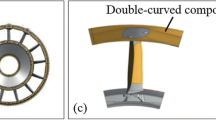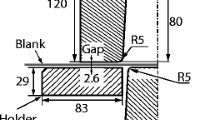Abstract
This study discusses the development of a numerical simulation model to predict press force and final deformation induced by welding-to-forming process chain with experimental validation. The numerical models of welding and forming were developed in sequence by utilizing two specialized virtual manufacturing software family namely Simufact.Welding (SW) and Simufact.Forming (SF). In the non-linear thermomechanical simulation, the GMAW process was firstly executed on a butt joint of mild steel S235 with thickness of 2 mm followed by bending process whereby the plate and dies geometry were modelled based on the actual dimension and the weld bead geometry was modelled by means of simplified shape. The result of transient welding simulation was transferred to forming which considers the final deformation and effective stress. For achieving realistic transient temperature distribution, the heat transfer coefficients during the welding process were calibrated on specific points measured by using thermocouple with data logger. For verification purpose, a series of comprehensive welding experiments was executed using robotic system followed by the metal bending process using hydraulic press machine. It can be observed at the final deformation results that the difference between simulation using SF-SW and experiment showed an acceptable error percentage within the range of 4 to 12% on each measurement point and up to 7% in average. The press force prediction showed an error percentage of up to 10% at lower-to-medium and up to 17% at high stroke section. Hence, by referring to the results, this study can be applied to select a suitable press machine for this specific coupled process based on estimated load range.


















Similar content being viewed by others
Data Availability
Not applicable.
Code Availability
Not applicable.
References
Djurdjanović D, Jiao Y, Majstorović V (2017) Multistage manufacturing process control robust to inaccurate knowledge about process noise. CIRP Ann 66:437–440. https://doi.org/10.1016/j.cirp.2017.04.012
Govik A, Nilsson L, Moshfegh R (2012) Finite element simulation of the manufacturing process chain of a Sheet Metal Assembly. J Mater Process Technol 212:1453–1462. https://doi.org/10.1016/j.jmatprotec.2012.02.012
Bernadskii VN (2001) Thin-sheet welded tailored blanks in automotive industry (review). Weld Int 15:898–906. https://doi.org/10.1080/09507110109549464
Lim Y, Chung J, Park C (2015) Allocation of the equipment path in a multi-stage manufacturing process. J Korean Stat Soc 44:366–375. https://doi.org/10.1016/j.jkss.2014.10.003
Zaeh M, Tekkaya A, Biermann D (2009) Integrated simulation of the process chain composite extrusion–milling–welding for lightweight frame structures. Prod Eng Res Devel 3:441–451. https://doi.org/10.1007/s11740-009-0190-0
Hyun S, Lindgren LE (2004) Simulating a chain of manufacturing processes using a geometry-based finite element code with adaptive meshing. Finite Elem Anal Des 40:511–528. https://doi.org/10.1016/s0168-874x(03)00075-1
Bauer A, Manurung Y, Sprungk J, Graf M, Awiszus B, Prajadhiana K (2019) Investigation on forming–welding process chain for DC04 tube manufacturing using experiment and FEM simulation. Int J Adv Manuf Technol 102:2399–2408. https://doi.org/10.1007/s00170-019-03320-1
Trautmann M, Hertel M, Füssel U (2017) Numerical simulation of TIG Weld Pool Dynamics using smoothed particle hydrodynamics. Int J Heat Mass Transf 115:842–853. https://doi.org/10.1016/j.ijheatmasstransfer.2017.08.060
Bang H (2015) Numerical analysis on the welding residual stress and fracture toughness of the heavy thick steel welded joints by welding processes. J Weld Join 33:32–39. https://doi.org/10.5781/jwj.2015.33.2.32
Chung H (2017) Numerical simulation of droplet transfer behavior in variable polarity gas metal arc welding. Int J Heat Mass Transf 111:1129–1141. https://doi.org/10.1016/j.ijheatmasstransfer.2017.04.090
Kah P, Shrestha M, Hiltunen E, Martikainen J (2015) Robotic arc welding sensors and programming in industrial applications. Int J Mech Mater Eng. https://doi.org/10.1186/s40712-015-0042-y
Okano S, Mochizuki M (2017) Transient distortion behavior during TIG welding of thin steel plate. J Mater Process Technol 241:103–111. https://doi.org/10.1016/j.jmatprotec.2016.11.006
Bate SK, Charles R, Warren A (2009) Finite element analysis of a single bead-on-plate specimen using SYSWELD. Int J Press Vessels Pip 86:73–78. https://doi.org/10.1016/j.ijpvp.2008.11.006
Gu Y, Yong Y (2019) Determination of parameters of double-ellipsoidal heat source model based on optimization method. Weld World 63:365–376. https://doi.org/10.1007/s40194-018-00678-w
Gupta S, Rajagopal D (2002) Sheet metal bending: forming part families for generating shared press-brake setups. J Manuf Syst 21:329–349. https://doi.org/10.1016/s0278-6125(02)80033-4
Hamid R (2016) Ito T (2016) Verification of sheet metal-based wire bending procedures. Proc Design Syst Conf 26:1403. https://doi.org/10.1299/jsmedsd.2016.26.1403
Panthi SK, Ramakrishnan N, Pathak KK, Chouhan JS (2007) An analysis of springback in sheet metal bending using finite element method (FEM). J Mater Process Technol 186:120–124. https://doi.org/10.1016/j.jmatprotec.2006.12.026
Bhav G, Praveen K, Vaibhav C, Kamal R (2016) Analysis of springback variation in V bending. Int J Eng Res. https://doi.org/10.17577/ijertv5is020526
Ghiotti A, Simonetto E, Bruschi S, Bariani P (2017) Springback measurement in three roll push bending process of hollow structural sections. CIRP Ann 66:289–292. https://doi.org/10.1016/j.cirp.2017.04.119
Trzepiecinski T, Lemu H (2017) Prediction of springback in V-die air bending process by using finite element method. MATEC Web of Conferences 121:03023. https://doi.org/10.1051/matecconf/201712103023
Karabulut S, Esen I (2021) Finite element analysis of springback of high-strength metal SCGA1180DUB while U-channeling, according to wall angle and die radius. https://doi.org/10.21203/rs.3.rs-517616/v1
Spathupoulos SC, Stavroulakis GE (2020) Springback prediction in sheet metal forming, based finite element analysis and artificial neural network approach. Applied Mechanics 1(2):97–110. https://doi.org/10.3390/applmech1020007
Durand RE, Bigot R, Baudoui C (2018) Contribution to characterization of metal forming machines: application to screw presses. Procedia Manuf 15:1024–1032. https://doi.org/10.1016/j.promfg.2018.07.391
Kumar A, Gulati V, Kumar P, Singh H (2019) Forming force in incremental sheet forming: a comparative analysis of the state of the art. J Braz Soc Mech Sci Eng. https://doi.org/10.1007/s40430-019-1755-2
Gavrilescu I, Boazu D, Stan F (2021) Estimating of bending force and curvature of the bending plate in a three-roller bending system using finite element simulation and analytical modeling. Materials 14:1204. https://doi.org/10.3390/ma14051204
Ni J, Abdel Wahab M (2017) A numerical kinematic model of welding process for low carbon steels. Comput Struct 186:35–49. https://doi.org/10.1016/j.compstruc.2017.03.009
Chelaru JD, Muresan LM (2019) Study of S235 steel corrosion process in wastewater from the petrochemical industry. Studia Universitatis Babeș-Bolyai Chemia 64:323–333. https://doi.org/10.24193/subbchem.2019.2.27
Heinze C, Schwenk C, Rethmeier M, Caron J (2011) Numerical sensitivity analysis of welding-induced residual stress depending on variations in continuous cooling transformation behavior. Front Mater Sci 5:168–178. https://doi.org/10.1007/s11706-011-0131-7
Acknowledgements
The authors would like to express their gratitude to staff members of Smart Manufacturing Research Institute (SMRI) and Research Interest Group: Advanced Manufacturing Technology (RIG:AMT) at School of Mechanical Engineering, Universiti Teknologi MARA (UiTM), Professorship of Virtual Production Engineering and Chair of Welding Engineering at Chemnitz University of Technology (CUT) in Germany for encouraging this research.
Funding
This research is financially supported by Fundamental Research Grant Scheme (FRGS) with Project Code: FRGS/1/2022/TK10/UiTM/02/84, Geran Konsortium Kecemerlangan Penyelidikan (Large Volume Additive Manufacturing/LVAM) from Ministry of Higher Education (MOHE) in Malaysia and DAAD Germany (Future Technology Additive Manufacturing) with Project Code: 57525437.
Author information
Authors and Affiliations
Corresponding author
Ethics declarations
Ethical approval
This article does not contain any studies with human participants or animals performed by any of the authors.
Consent to participate
Not applicable.
Consent for publication
Not applicable.
Conflict of Interest
The authors declare no competing interests.
Additional information
Publisher's note
Springer Nature remains neutral with regard to jurisdictional claims in published maps and institutional affiliations.
Rights and permissions
Springer Nature or its licensor (e.g. a society or other partner) holds exclusive rights to this article under a publishing agreement with the author(s) or other rightsholder(s); author self-archiving of the accepted manuscript version of this article is solely governed by the terms of such publishing agreement and applicable law.
About this article
Cite this article
Adenan, M.S., Prajadhiana, K.P., Mat, M.F. et al. Chained simulation of the welding-forming process in analysing press force and geometrical deformation using non-linear numerical computation with experimental validation. Int J Adv Manuf Technol 125, 4631–4646 (2023). https://doi.org/10.1007/s00170-023-11069-x
Received:
Accepted:
Published:
Issue Date:
DOI: https://doi.org/10.1007/s00170-023-11069-x




